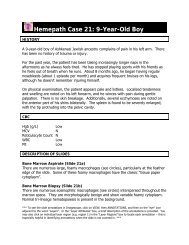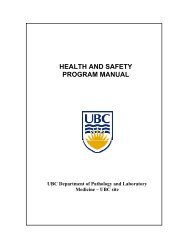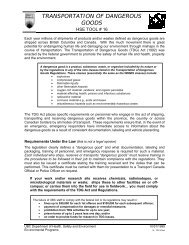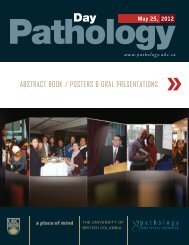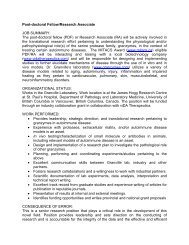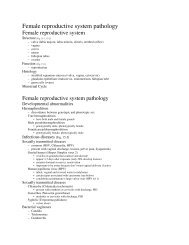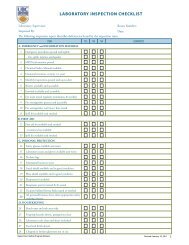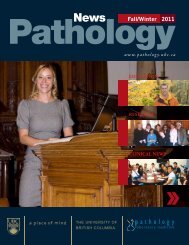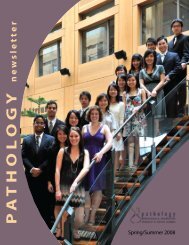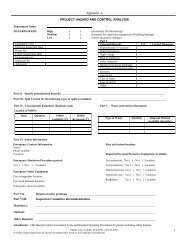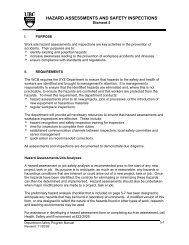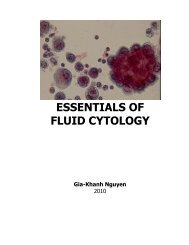Post-doctoral FellowAbstract # 51Guangzheng Gao, Jason Kindrachuk, Donald E. Brooks, Robert E.W. Hancock,<strong>and</strong> Jayach<strong>and</strong>ran N. KizhakkedathuCentre for Blood Research, Department of <strong>Pathology</strong> <strong>and</strong> <strong>Laboratory</strong> <strong>Medicine</strong>Gao Guangzhengshort antimicrobial peptides immobilized copolymerbrushes on titanium surfaceBackround/ObjectivesImplant-associated infection is one of the most challenging postoperative complications, especially in the case oforthopedic implants. Thus the design of novel anti-infective implant surfaces would be highly advantageous withsignificant benefit to both patients <strong>and</strong> the health care system. A potential alternative to current antibiotics isantimicrobial peptides (AMPs) that are found in the immune system of almost all species of life.In the present work, we investigated the immobilization of small AMPs on titanium surfaces using novel functionalcopolymer brushes.We show that the properties of the copolymer brushes significantly affect the peptide density onthe brushes <strong>and</strong> their antimicrobial activity.MethodsWe synthesized of primary amine functionalized copolymer brushes on Ti surface using surface initiated atomtransfer radical polymerization (SI-ATRP) technique <strong>and</strong> developed methods for the efficient conjugation of cysteinecontaining AMPs on copolymers brushes <strong>and</strong> their characterization. Antibacterial analyses were conducted byincubating Tet-213 immobilized Ti plates <strong>and</strong> corresponding control samples in a 24-well microtiter plate with luxstrain culture. Luminescence emission was examined by a TECAN® Spectrafluor Plus spectrometer (TECAN U.S.,Inc.).ResultsN-(3-Aminopropyl)methacrylamide hydrochloride (APMA) <strong>and</strong> N, N-Dimethyl acrylamide (DMA) copolymerbrushes were synthesized on Ti surface by surface initiated ATRP in aqueous conditions at room temperature.Cysteine-containing AMP Tet-213 was conjugated to the copolymer brushes after modification of amine groupsto maleimide groups. The antimicrobial properties of the selected peptide-coated samples were analyzed usingPseudomonas aeruginosa (P. aeruginosa) strain PA01 that expresses a luciferase gene. Our preliminary data show thatthe polymer brushes grafted Tet-213 retains antimicrobial activity. Bacterial growth inhibition could reach 80%.ConclusionWe showed that the primary amine groups within the brushes were highly reactive to small molecules, <strong>and</strong> almostquantitative conversion of amine groups to maleimide groups was obtained. The peptide conjugation of copolymerbrushes depended on molecular weight, graft density <strong>and</strong> composition. The graft density of the chains on the brushesshowed significant influence on the peptide conjugation unlike other parameters. Many folds higher peptide density onthe surface was achieved when the brush layer was used for conjugation. As a proof-of-concept, we showed that peptideconjugated copolymer brushes were antimicrobial.62 2 0 1 0 * P o s t e r P r e s e n t a t i o n s
Graduate StudentJasmine L. Hamilton, Muhammed Imran ul-haq, Iren Constantinescu, <strong>and</strong>Jayach<strong>and</strong>ran N. KizhakkedathuCentre for Blood Research, The <strong>University</strong> of British Columbia, Life Sciences CentreJasmine Lajuanie Hamiltonmacromolecular iron chelators: a novel therapeuticagent for the treatment of secondary iron overloadAbstract # 52Backround/ObjectivesTransfusion therapy has improved the quality of life <strong>and</strong> prolonged survival for many patients with inherited <strong>and</strong>acquired refractory anemias such as sickle-cell <strong>and</strong> thalassemia. However, the human body lacks a physiologicalmechanism to actively excrete excess iron; therefore, repeated blood transfusions lead to increased body iron burdenor secondary iron overload. Excess iron catalyzes the formation of very injurious compounds, such as the hydroxylradical, which is highly reactive, <strong>and</strong> attacks lipids, proteins, <strong>and</strong> DNA in major organs. Additionally, iron-mediatedcarcinogenesis is thought to occur through the generation of oxygen radicals. Iron overload is thus involved in thepathogenesis of many diseases. Desferrioxamine (DFO) is the most widely used iron chelating drug, but has significantdisadvantages, including its high cost <strong>and</strong> continuous subcutaneous mode of administration for 8-12 hours perday, 5-7 days a week. Since molecular weight (MW) strongly influences the cell permeability, toxicity, <strong>and</strong> plasmahalf-life of drug molecules, we hypothesize that a macromolecular system with iron binding groups attached to abiocompatible polymer will reduce the systemic toxicity <strong>and</strong> increase plasma residence time of current iron chelatorsthereby increasing the therapeutic efficiency.MethodsOur group has recently developed a novel blood compatible hyperbranched polyglycerol (HPG) based iron chelatorsystem. We conjugated HPGs of defined MW to low MW DFO. HPGs were initially oxidized with sodium periodate(NaIO4) to generate reactive aldehyde groups from 1,2 diol groups on the HPGs. Aldehyde groups were coupledwith DFO via Schiff base reaction followed by reduction with sodium cyanoborohydride (NaCNBH3). Remainingaldehyde groups were quenched using excess glycine or ethanolamine. The iron-binding efficiency as well as theability of HPG-DFO conjugates to prevent iron mediated oxidation of proteins were determined by UV-VisibleSpectroscopy. Blood compatibility of these conjugates was analyzed by coagulation assays including ProthrombinTime (PT), Activated Partial Thromboplastin Time (APTT), <strong>and</strong> Thromboelastography (TEG); platelet activation,<strong>and</strong> red cell aggregation.ResultsCharacterization of novel HPG-DFO conjugates using UV-Visible Spectroscopy demonstrates that the iron bindingproperties of DFO remains unaffected after conjugation. Additionally, HPG-DFO was effective at preventing ironmediatedoxidation of our hemoglobin oxida tion model. Blood compatibility analysis did not show any significantchanges in blood coagulation, platelet activation, hemolysis, or aggregation in vitro.ConclusionThe synthesis of a novel class of iron binding, HPG based chelator is described. The iron binding property of DFO isnot hindered once conjugated to the HPG. Blood compatibility analyses indicate that the new polymer-based chelatoris highly biocompatible. Currently we are continuing studies on cell toxicity <strong>and</strong> in vivo analysis of these moleculesin mice. A successful outcome would benefit millions of people, especially iron overloaded sickle-cell <strong>and</strong> thalassemicpatients.Poster <strong>Presentations</strong> * 2 0 1 063
- Page 2:
PathDay: Keynote Speaker (4:30 pm)T
- Page 5:
Conference Outline2010abstract #14
- Page 9 and 10:
Table of Contentabstract #57 The ro
- Page 11 and 12: ResidentClinical SciencesArwa Al-Ri
- Page 13 and 14: ResidentTitus Wong 1 , Marc Romney,
- Page 17 and 18: ResidentD. Turbin 1 , D. Gao 2 , J.
- Page 19 and 20: ResidentDavid F Schaeffer 1 , Eric
- Page 21 and 22: ResidentMajid Zolein 1 , Daniel T.
- Page 23 and 24: Graduate StudentAshish K. Marwaha 1
- Page 25 and 26: Graduate StudentAmanda Vanden Hoek
- Page 27 and 28: Graduate StudentXin Ye 1 , Mary Zha
- Page 29: Graduate StudentLisa S. Ang 1 , Sar
- Page 32 and 33: Graduate StudentAbstract # 22Brian
- Page 36 and 37: OtherAbstract # 25Crystal Leung, Li
- Page 38 and 39: OtherAbstract # 27Lise Matzke 1 , W
- Page 40 and 41: Graduate StudentAbstract # 29Varun
- Page 42 and 43: Graduate StudentAbstract # 31Maite
- Page 44 and 45: Post-doctoral FellowAbstract # 33Ra
- Page 46 and 47: Graduate StudentAbstract # 35Hayley
- Page 48: Post-doctoral FellowAbstract # 37Es
- Page 51 and 52: ResidentAhmad Al-Sarraf MD 1, 2 , G
- Page 53 and 54: OtherRebecca Towle 1 , Danielle Mac
- Page 55 and 56: Graduate StudentPaul R. Hiebert 1,2
- Page 57 and 58: Graduate StudentV. Montoya 1 , J. G
- Page 59 and 60: OtherWalter Martz and Henry Kalicia
- Page 61: OtherKatelyn J. Janzen 1 , Elizabet
- Page 65 and 66: Graduate StudentIan M. Wilson 1 , K
- Page 67 and 68: Graduate StudentKelsie L. Thu 1,3 ,
- Page 69 and 70: OtherLiat Apel-Sarid 1 , Doug Cochr
- Page 71 and 72: Graduate StudentJennifer R. Choo 1,
- Page 73 and 74: Graduate StudentEdwin S. Gershom 1
- Page 75 and 76: OtherYing Qiao 1, 2 , Chansonette H
- Page 77 and 78: Graduate StudentLeslie YM Chin 1,4
- Page 79 and 80: Graduate StudentBillie Velapatiño
- Page 81 and 82: Graduate StudentSophie Stukas 1 , S
- Page 83 and 84: Graduate StudentKyluik DL and Scott
- Page 85 and 86: Post-doctoral FellowJoel Montane 1
- Page 87 and 88: IndexAAbozina A. 45Abraham T. 55All
- Page 89: Ye X. 27, 82Yee S. 31Yoshida E. 12Y



